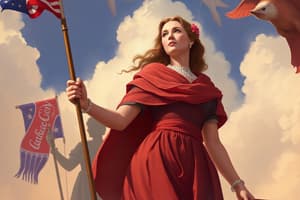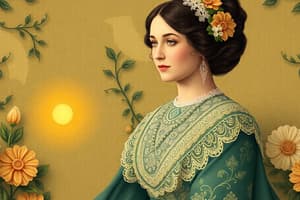Podcast
Questions and Answers
What was Susan B. Anthony's primary motivation for voting illegally in 1872?
What was Susan B. Anthony's primary motivation for voting illegally in 1872?
- To influence the outcome of the presidential election
- To challenge the legality of her actions in court (correct)
- To demonstrate the support of men for women's suffrage
- To protest against the prohibition of women's voting rights
What was the consequence of Susan B. Anthony's illegal voting in 1872?
What was the consequence of Susan B. Anthony's illegal voting in 1872?
- She faced no legal repercussions.
- She successfully overturned the law.
- She was fined $100 but refused to pay. (correct)
- She was imprisoned for a year.
Which amendment is associated with Susan B. Anthony's efforts?
Which amendment is associated with Susan B. Anthony's efforts?
- The Fourteenth Amendment
- The Nineteenth Amendment
- The Civil Rights Amendment
- The Susan B. Anthony Amendment (correct)
How did Susan B. Anthony feel about the future of women's suffrage at the end of her life?
How did Susan B. Anthony feel about the future of women's suffrage at the end of her life?
How did the marshal respond when he was sent to arrest Susan B. Anthony?
How did the marshal respond when he was sent to arrest Susan B. Anthony?
What was one result of Susan B. Anthony's teaching job experiences?
What was one result of Susan B. Anthony's teaching job experiences?
What was one of Susan B. Anthony's initial activism focuses?
What was one of Susan B. Anthony's initial activism focuses?
What was the primary reason for the split between the National Woman Suffrage Association and the American Woman Suffrage Association?
What was the primary reason for the split between the National Woman Suffrage Association and the American Woman Suffrage Association?
Which statement accurately reflects Susan B. Anthony's early education?
Which statement accurately reflects Susan B. Anthony's early education?
Which major event or situation influenced Susan B. Anthony's activism?
Which major event or situation influenced Susan B. Anthony's activism?
Which statement best reflects Susan B. Anthony's and Elizabeth Cady Stanton's views on the Fifteenth Amendment?
Which statement best reflects Susan B. Anthony's and Elizabeth Cady Stanton's views on the Fifteenth Amendment?
Why was Western New York State considered a hotbed of social activism in the 1800s?
Why was Western New York State considered a hotbed of social activism in the 1800s?
How did Susan B. Anthony contribute to the women's suffrage movement?
How did Susan B. Anthony contribute to the women's suffrage movement?
What was characteristic of Susan B. Anthony's appearance that matched her activism style?
What was characteristic of Susan B. Anthony's appearance that matched her activism style?
What was the title of the magazine that Susan B. Anthony and Elizabeth Cady Stanton published?
What was the title of the magazine that Susan B. Anthony and Elizabeth Cady Stanton published?
Which of the following individuals was connected with the women's rights movement in Western New York?
Which of the following individuals was connected with the women's rights movement in Western New York?
What did Susan B. Anthony express as a desired outcome of women's suffrage?
What did Susan B. Anthony express as a desired outcome of women's suffrage?
What significant act was performed by Florence Chauncey?
What significant act was performed by Florence Chauncey?
What did the masthead of The Revolution declare regarding rights?
What did the masthead of The Revolution declare regarding rights?
Which group was The New York Times referring to as 'literary nitroglycerin'?
Which group was The New York Times referring to as 'literary nitroglycerin'?
What did Susan B. Anthony later declare about who should vote first?
What did Susan B. Anthony later declare about who should vote first?
Flashcards
Woman Suffrage
Woman Suffrage
The belief that women should have the right to vote.
Susan B. Anthony's Argument
Susan B. Anthony's Argument
The 15th Amendment granted African American men the right to vote, but Susan B. Anthony argued that women should have the same right.
Susan B. Anthony's Act of Rebellion
Susan B. Anthony's Act of Rebellion
Susan B. Anthony's act of voting in a presidential election, despite it being illegal. It aimed to bring the issue of women's suffrage to the courts.
Susan B. Anthony's Arrest and Trial
Susan B. Anthony's Arrest and Trial
Signup and view all the flashcards
The Susan B. Anthony Amendment
The Susan B. Anthony Amendment
Signup and view all the flashcards
The Burned-Over District
The Burned-Over District
Signup and view all the flashcards
Temperance Movement
Temperance Movement
Signup and view all the flashcards
Suffrage
Suffrage
Signup and view all the flashcards
Women, Their Rights, and Nothing Less
Women, Their Rights, and Nothing Less
Signup and view all the flashcards
Elizabeth Cady Stanton
Elizabeth Cady Stanton
Signup and view all the flashcards
Florence Chauncey
Florence Chauncey
Signup and view all the flashcards
The North Star
The North Star
Signup and view all the flashcards
Declaration of Sentiments
Declaration of Sentiments
Signup and view all the flashcards
Susan B. Anthony and Elizabeth Cady Stanton
Susan B. Anthony and Elizabeth Cady Stanton
Signup and view all the flashcards
What did Susan B. Anthony and Elizabeth Cady Stanton think of the Fifteenth Amendment?
What did Susan B. Anthony and Elizabeth Cady Stanton think of the Fifteenth Amendment?
Signup and view all the flashcards
How did the public view Susan B. Anthony and Elizabeth Cady Stanton's views?
How did the public view Susan B. Anthony and Elizabeth Cady Stanton's views?
Signup and view all the flashcards
What did Susan B. Anthony and Elizabeth Cady Stanton mean by the "aristocracy of sex"?
What did Susan B. Anthony and Elizabeth Cady Stanton mean by the "aristocracy of sex"?
Signup and view all the flashcards
What was The Revolution?
What was The Revolution?
Signup and view all the flashcards
Why did The New York Times call The Revolution "literary nitroglycerin"?
Why did The New York Times call The Revolution "literary nitroglycerin"?
Signup and view all the flashcards
What were Susan B. Anthony's views on women's suffrage?
What were Susan B. Anthony's views on women's suffrage?
Signup and view all the flashcards
How did Susan B. Anthony's strong personality affect the women's rights movement?
How did Susan B. Anthony's strong personality affect the women's rights movement?
Signup and view all the flashcards
Study Notes
Susan B. Anthony's Life and Activism
- Susan B. Anthony (February 15, 1820 – March 13, 1906) was a prominent American social reformer and women's rights advocate.
- She was born into a Quaker family, who believed in equality between men and women.
- Denied advanced math in school, setting her on a path to advocate for women's rights.
- Her father's cotton mill business failure led to a life of hard work, including innkeeping and teaching.
- Her early experiences showed gender inequality, particularly in pay for teachers.
- Started her activism with the temperance movement, but later focused solely on women's suffrage.
- She believed that women should have equal rights to men.
- Formed a fierce partnership with Elizabeth Cady Stanton, collaborating on causes for over 50 years.
- Published a magazine, The Revolution, to express radical views on women's rights.
- Believed women deserved the right to vote (suffrage) and vigorously campaigned for equality.
- Arrested for voting in the presidential election of 1872.
- Ultimately, her efforts contributed significantly to the women's suffrage movement.
Key Events in Susan B. Anthony's Life
- 1837: Loss of family business due to recession.
- 1837-1850s: Worked as a teacher, innkeeper, and other roles.
- 1851: Met Elizabeth Cady Stanton, forming a powerful partnership.
- 1868: Founded The Revolution, a women's rights newspaper.
- 1872: Arrested for illegally voting in a presidential election.
- 1906: Died, with the women's suffrage struggle ongoing.
Women's Rights Movement Context
- Early 1800's, Western New York was known as the "Burned-Over District" with high social activism.
- Second Great Awakening fueled religious and social reform movements.
- Rochester, NY, was home to Frederick Douglass, who helped publish The North Star.
- The Western New York region was home to important figures in the women's rights movement and other social reformers.
- The women's rights movement, gaining momentum, faced inequality and resistance.
Studying That Suits You
Use AI to generate personalized quizzes and flashcards to suit your learning preferences.




